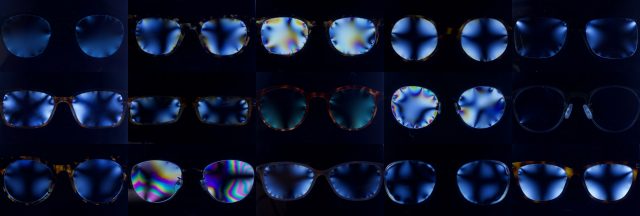 Many people are completely dependent on corrective lenses without knowing how they work; this project examines the invisible stresses we put in & around our eyes every day.
Many people are completely dependent on corrective lenses without knowing how they work; this project examines the invisible stresses we put in & around our eyes every day. I have worn glasses since I was 5 years old, and contacts since I was 8, but I’ve never stopped to think about their construction. In learning about polarized light, however, I realized that transparent plastic is not perfect; in fact, it is subject to stress that can be seen clearly when place between two perpendicular polarizing filters.
The goal: view the stresses in corrective lenses.
I: Contact Lenses
What are the stresses on my contact lenses? Is there a difference in stress between a fresh pair and a used pair?
I wear daily lenses, which means I throw them out every night. Rather than throw them out, I saved my used contacts for a week, so I could compare their stresses with fresh ones.
The Machine
The machine was pretty simple:
-
Soft contact lenses (used & unused)
-
Linear polarizing filters (2)
-
DSLR with macro lens
-
Light table
I was excited to use polarizing filters because of how clearly they highlight points of stress; I hoped to see the tiny stresses in the things I put in my eyes every single day.
So I put a contact lens between 2 filters and…nothing happened.
Thus entered the experimentation phase.
Experiments
First, I did some research – why did this not work? Despite the objective “failure,” it was honestly really fascinating to learn how contacts are built.
Next, I tried a bunch of ideas:
- What happens if you squish it? Stretch it?
- Let it dry out & shrivel up?
- Let it dry out and shatter it?
- What about in the packaging?
II: Glasses
Luckily, I had also brought my glasses as a backup plan.
What are the stresses on my glasses lenses? What do lens stresses look like for different people, types of frames, prescriptions, etc.?
The Machine:
-
Glasses (15 distinct pairs)
-
Linear polarizing filters (2)
-
DSLR with macro lens; fstop 8 & lowest ISO setting
-
Light table
These photos were immediately more interesting. The hard plastic of the glasses made for better results with the polarization filters, plus the frames themselves exert those stresses.
To me, the most interesting part of it was not the stresses of a single frame, but in the comparison. Different frames show stress in drastically different ways. Some key interesting ones:
Thank you to everybody who donated your glasses to the cause – I really appreciate it!
III: Insights & Reflections
-
Glasses are a proxy for people. There’s a story to each lens/frame/wearer. Everyone apologizes for their glasses being dirty.
-
We put a lot of trust on glasses without knowing how they really work. They are not as perfect as we think.
-
“Experimental capture” is no joke – it truly is an experiment.
-
I succeeded in keeping it simple. Throughout my masters program, I’ve learned the importance of “doing one thing well” rather than trying to do it all. Especially in this class, there’s a lot of pressure to use all of the tools. I’m grateful I made a relatively low-tech machine; this helped me learn, adapt, and focus on the storytelling.
-
I failed in anticipating some of the challenges that could arise – I gave myself enough time for plan A but could have left more for plan B.
-
Selecting which frames to photograph is part of the machine. With more time, I could have been more strategic about location and context for choosing subjects.
IV: Future Opportunities
Now That I’ve learned a lot about lenses (for better and for worse), I’m curious about their imperfections. How might I visualize the stresses I found? Does this stress affect what the viewer actually sees?
Seam Carving
Seeing these distortions through the polarizing filters, I was immediately reminded of a funhouse mirror.
Thanks to a suggestion from Kyle, I learned about Seam Carving and explored this a bit. Seam carving is usually used for resizing an image without losing “important” data; it preserves the spaces with the most “energy” and algorithmically carves away the less valuable things in between.
For scaling down, this pretty much looked like a “crop.” Not very interesting here. But for scaling up, I started to see some fun distortions.
UV Experiments
In trying to figure out why the polarizing filters didn’t work, I also learned that some contacts have UV blockers. Here’s what a few different brands look like under UV light:
With a UV camera, some interesting future experiments could arise. If I took a UV self-portrait, what would my eyes look like?